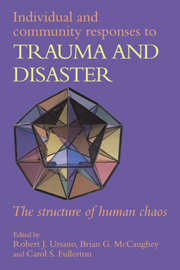Book contents
- Frontmatter
- Contents
- List of contributors
- Foreword
- Preface
- Part I Introduction
- Part II The nature of traumatic stress
- Part III The role of psychosocial context in responses to trauma and disasters
- 8 Social support and perceived control as moderators of responses to dioxin and flood exposure
- 9 Debriefing following traumatic exposure
- 10 Relocation stress following natural disasters
- 11 Group reactions to trauma: an avalanche accident
- 12 Community responses to disaster: the Gander plane crash
- Part IV Responses to trauma across the life cycle
- Part V Conclusions
- Index
10 - Relocation stress following natural disasters
from Part III - The role of psychosocial context in responses to trauma and disasters
Published online by Cambridge University Press: 13 October 2009
- Frontmatter
- Contents
- List of contributors
- Foreword
- Preface
- Part I Introduction
- Part II The nature of traumatic stress
- Part III The role of psychosocial context in responses to trauma and disasters
- 8 Social support and perceived control as moderators of responses to dioxin and flood exposure
- 9 Debriefing following traumatic exposure
- 10 Relocation stress following natural disasters
- 11 Group reactions to trauma: an avalanche accident
- 12 Community responses to disaster: the Gander plane crash
- Part IV Responses to trauma across the life cycle
- Part V Conclusions
- Index
Summary
The thing is, it makes you realize how fast and easy you can lose everything you've worked a long time to get. You find out that life goes on and that maybe there are more important things than money and possessions. These can be swept away in an instant. Family and friends, your happiness in life, is where it's all at.
(West Virginia mother, 3 months after a flood destroyed her family's home)Natural disasters account for much of the damage and destruction of homes in the United States. During the years 1965–1985, 531 major natural disasters occurred in the United States resulting in widespread destruction and loss of life (Rubin et al., 1986). This figure represents federally declared disasters including hurricanes and tropical storms, ice and snow events, earthquakes, dam failures, flooding, high winds, coastal storms, tornadoes, and drought. The resulting expenditures of federal money reached $6 billion, with millions more paid by state and local governments.
The total cost of this destruction is estimated to be even higher, about two and a half times the value of building losses. This final figure includes the individual costs borne by disaster victims themselves, estimated to be an additional 75% beyond government estimated figures (Rubin et al., 1986). During this same period (1965–85), the number of dwellings destroyed and damaged is estimated at 1½ million, with floods accounting for about 750 000 of these losses.
- Type
- Chapter
- Information
- Individual and Community Responses to Trauma and DisasterThe Structure of Human Chaos, pp. 220 - 247Publisher: Cambridge University PressPrint publication year: 1994
- 5
- Cited by



